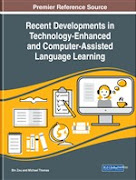I've been doing lots of readings and deep reflections lately, and I feel the urge to put my thoughts in writing so I can get back to them when I need to. In this post, I'd like to share what I call as - to borrow Clandinin's (2013) term - the 'narrative beginning.' I plan to make this a series of posts on using digital technologies in low-resource ELT context, where I'll try to share my reflections from my readings as well as observations, conversations with teachers and students, and experiences as an EL teacher in this school where I'm currently teaching in (more on my present context in the next post).
But for now, let's begin from the beginning - where it all started.
Developing a 'relationship' with technology
When I attended university for my undergraduate study in the late 1990’s, I found myself struggling to complete my class assignments as everything needed to be typewritten. By working as a part-time shop assistant, I was able to collect enough money to purchase a nice, electric typewriter which I used to type all of my university papers. The challenge, however, was when it came to graphs, tables and charts. The electric typewriter was wonderful, but the functions were limited – the task was beyond what it was able to do. I was not allowed to submit hand-drawn tables and charts. For the whole first semester of my undergraduate study, my solution to this problem was to pay the printing shop to convert my hand-drawn tables and charts into an acceptable format for submission.
Printing in shops were expensive, and I did not want to spend any more of my fast-depleting student allowances and shop assistant’s salary on printing graphs and charts. I realised that I needed to do something; that I needed to learn how to use the computer properly. I took classes, spent a lot of time at cyber cafes, and mingled with people who were more tech-savvy than I was. Eventually, I was able to master sufficient technology skills to enable me to go through the rest of my study with less difficulty than before. I sold my faithful electric typewriter and worked harder to collect more money so I could buy a second-hand laptop to type my assignments and to draw graphs, tables and charts using the word processor. I also learned how to use the Internet and to explore ways to utilise the wealth of information that I could access from the World Wide Web to my academic advantage.
Then I became a teacher...
In 2005, I started a job as a primary school ESL teacher in a rural area about 500 kilometers away from my hometown. It was a beautiful school in a village by the sea. At this point, I thought my ‘relationship’ with technology was over. I did not see a need for me to learn any more technology skills any further. My use of technology was limited to typing reports for the school and occasionally to print out worksheets for my students. The school had very limited technology facilities and no access to the Internet. As a young teacher, I was far from perfect; but I was quite happy with teaching with little or no technology at all. I saw myself as a creative ESL teacher who knew how to make language lessons fun and engaging for my students through the use of non-digital materials such as music, stories and arts. I did not see any need for me to integrate technology in my classroom.
This changed in my third or fourth year of teaching, when I was instructed by my school to attend an orientation course on technology integration in the classroom, initiated by the Technology Education Division of the Ministry of Education. Through the two-week course, I was exposed to numerous technology software and applications, and was given the chance to explore the potentials of technology to enhance my students’ learning. I went back to school with a new-found appreciation and enthusiasm for technology in education.
The course opened my eyes to the many wonders and potentials of technology as a tool for language teaching and learning, yet I found it really difficult to apply what I learned from the course to my practice in the classroom. To begin with, the school did not even have enough computers. The ratio was one laptop per 10 students – not to mention almost half of the laptops were outdated and barely functioning. The best I could do was to borrow an LCD projector from the school’s ICT lab and used my own laptop to project digital language learning materials on a makeshift LCD screen of white construction papers pasted on my classroom wall. This, however, did not deter me from integrating technology into my language lessons. I remember looking back often at my experience as a young undergraduate struggling with technology because my early education in rural primary and secondary schools did not provide me with the opportunities to learn how to use a computer when I was younger. I was motivated to expose my rural students to technology so that they would not have to struggle as much as I did when they pursue their education at a higher level.
Things got better...
Things got better in my seventh or eighth year of teaching, when the school finally moved to a new building with a shiny computer lab. We had ten new PCs, and finally access to the Internet. I had more years of teaching experiences under my belt, and more wisdom and maturity as a teacher. That was when I decided to embark on my first big technology-based classroom project with my students.
The project was aimed at improving my students’ reading comprehension using audiobooks. The first stage of the project involved the students using the PCs in the computer lab to access free online audiobooks. In the second stage, the students created their own audiobooks. To provide a platform for the students to share their audiobooks and to receive feedbacks from one another, a class blog was created where the students could upload their works and access each other’s works. The project was effective in enhancing the students’ reading comprehension skills and in improving their motivation to read (see James, 2015. See also my blogpost on the project).
When I moved back to my hometown to teach in a suburban primary school in 2015, I had developed a whole new outlook on the use of technology in the classroom. I had developed a better understanding of how – to use Shulman’s (1987) terms – to adapt and tailor my strategies and approaches based on my students’ needs, contexts and circumstances. I embarked on another technology-based classroom project – this time focusing on the use of mobile phones and blog to improve students’ performances and motivation in story-writing. The impacts of the project were documented in a report for Cambridge University Press’ Teacher Research Programme (see James, 2016. See also my blogpost on the project).
Sharing with others
Throughout the years, I had a lot of opportunities to share my enhanced technological knowledge with my colleagues and fellow teachers when I was appointed as one of the master trainers for technology in education. Most of the trainings were conducted based on the cascade model, where master trainers trained district representatives who would train teachers in their respective districts. These teachers would then train their colleagues in their respective schools. As I conducted the trainings, I could not help but look back at my first-time experience of attending the two-week orientation course on technology integration when I was just starting as a teacher. I reflected on how the experience inspired me so much, and how quickly the inspiration turned to frustration as I encountered constraints and challenges in implementing what I learned from the training to my practice in the classroom. I could see teachers just like myself, getting enthusiastic and inspired by the vast potentials of technology as a tool to enhance students’ learning. Yet I also wondered whether these teachers would have to face frustrations and obstacles just like I did, and whether the challenges they faced would demotivate them to embark on further explorations of the possibilities that technology can offer for their classrooms.
When I joined the Education Office as a supervisor of English language programmes in my district, I was moved to explore more innovative ways to help ESL teachers just like myself to learn about technology and to discover opportunities for using it in their language classrooms in meaningful and impactful manner. I wanted to provide a platform where teachers can learn from one another and collaborate in more interactive and divergent ways, instead of learning in a linear and passive manner from a master trainer. The platform should provide lots of opportunities for teachers to explore ways to adopt and tailor the knowledge they acquire to match the unique and individual needs and contexts of their students and classrooms. To start off, I sought the assistance of experts from the local university and together we initiated a TPACK-based professional learning community as a way to provide this envisioned platform. In 2016, ‘Going Digital’ was born.
To be continued...
I'll need to stop here for now. In the next post, I hope to share more about 'Going Digital' and what I learned from my experiences of working with teachers in my district, teaching in various low-resource EL contexts.
Till the next post! -ccj, 4.10 am, Duvanson
References
Clandinin, D. J. (2013). Engaging in narrative inquiry. New York: Routledge.
James, C.C. (2016). Improving children's writing skills through digital story prompts and feedback. Cambridge University Press Teacher Research Programme. Link
James, C.C. (2015). Engaging reluctant readers through audiobook project. International Journal on e-Learning Practices (IJELP), 2, 81-102. Link


















No comments:
Post a Comment